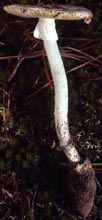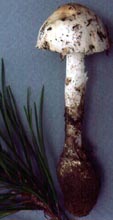[ Section Lepidella page. ]
[ Amanita Studies home. ]
[ Keys & Checklist/Picturebooks ]
[ New Jersey & region list ]
[ E. Texas & Gulf Coast list ]
"Narrowest-Spored Limbed Lepidella"




Technical description (t.b.d.)
BRIEF DESCRIPTION: The cap of Amanita cylindrispora is 40 - 80 mm wide, white to whitish to pale grayish white, graying or browning slightly over disk in age, occasionally with one or a few small rust-colored spots, subviscid at first, shiny when dry, hemispheric becoming convex, finally plano-convex; context 2 - 5 mm thick at stipe, white, thinning evenly to margin; margin nonstriate, slightly incurved at first, then decurved, frequently minutely appendiculate with white small membranous patches and/or white fibrillose material (lens); pileipellis separable; universal veil absent or occasionally as a single, easily removable, membranous whitish or pale grayish patch. The pileus may be partially expanded and still be well-below the surface of the soil substrate (right most photo, cap covered with sand).
The gills of A. cylindrispora are free to narrowly adnate with a sometimes faint, short decurrent line on stipe (lens), occasionally with a decurrent tooth on stipe, close to subcrowded to crowded, white to whitish to "pale pink to rosy-isabelline" to sordid cream (age) in mass, paler in side view, occasionally watersoaked after rain, not bruising or staining, 3 - 5 (-8) mm broad; margins white, flocculose (lens)/ The short gills are truncate to rounded truncate to subattenuate to attenuate after a step to attenuate (longest).
The stipe is 60 - 117 x 8 - 15 mm, largely or entirely buried in the substrate (see, especially, center two photos, above), white, cylindric to slightly narrowing upward, slightly or not flaring at apex, browning somewhat from handling, fibrillose to finely pulverulent/fibrillose (lens), finely longitudinally striate (lens) with thin, appressed, white patches distributed over lower portion; context white to pale sordid, not staining or bruising, can become watersoaked after rain, larva tunnels concolorous to slightly sordid or water soaked, solid or firmly stuffed at first or hollow above with 2 - 6 mm wide central cylinder and firmly stuffed below; bulb 23 - 34 x 13 - 23 mm (Beardslee: bulb 50 - 70 mm long), rounded below (subclavate) to napiform to very slenderly fusiform to subfusiform, subradicating to radicating, occasionally doglegged, with white mycelium at base. The annulus is apical to subapical, white, delicate, skirtlike, membranous, flaring at first, later becoming appressed, upper surface striate, lower surface floccose/fibrillose, occasionally found with a thin membranous volval internal limb hanging in whole or part from margin. The volva is membranous to submembranous, limbate, torn into irregular lobes, smooth surfaced or impregnated with sand, white with occasional reddish or reddish brown stains, sometimes a pinkish tint on the interior surface, occasionally(?) "bruising pinkish" (Murrill, regarding F17658), thin (less than 1 mm thick), upstanding at first and separated from the stipe barely (often with no evidence of an internal limb) or (less often) by width of complete, or rounded remnant of, internal limb, adnate for about half to two-thirds of limb height; height from highest tip of limb to bottom of bulb 33 - 62 mm (Beardslee: free limb 20 - 40 mm long).
Odor is lacking or is faintly of decay in age or occasionally of "chlorine" (Beardslee). The taste is mild (Murrill F17658).
The spores measure (7.8-) 11.5 - 15.8 (-24.5) x (3.2-) 3.8 - 5.0 (-6.2) Ám and are cylindric to bacilliform (rarely elongate) and amyloid. Clamps are absent from bases of basidia.
The species does not contain amatoxins (H. E. Hallen, pers. comm.).
Amanita cylindrispora occurs in the sandy soils of the Atlantic coastal plain from Long Island, New York south to Florida (from which it was originally described) and, in similar soils north of the U.S. coast of the Gulf of Mexico, at least as far west as eastern Texas. Its major symbionts appear to be oak (Quercus) and pine (Pinus); sometimes beech (Fagus grandifolia) may be present in the oak forests. Photographs of the the type collection (including Beardslee's photograph of the fresh material) can be found here.
Elongate bulbs, narrow spores, and fruiting bodies deeply inserted in the soil are often associated with "leaky" ecosystems (Tulloss 2005).
This species is most similar morphologically to a southern European and north African species, Amanita gilbertii Beauseign. Recent molecular studies by Dr. Heather E. Hallen (MSU) support morphological studies concerning a close relationship between the two taxa. At the moment, I believe the present species is best placed in subsection Limbatulae Bas. Following the system of Bas (1969), I designate a new Stirps Cylindrispora to include A. cylindrispora and A. gilbertii. -- R. E. Tulloss
Photos: R. E. Tulloss (New Jersey, U.S.A.)
[ Section Lepidella page. ]
[ Amanita Studies home. ]
[ Keys & Checklist/Picturebooks ]
[ New Jersey & region list ]
[ E. Texas & Gulf Coast list ]
Last changed 6 March 2009.
This page is maintained by R. E. Tulloss.
Copyright 2002, 2003, 2004, 2005, 2006, 2007, 2009 by Rodham E. Tulloss.
Photographs copyright 2002 by Rodham E. Tulloss.